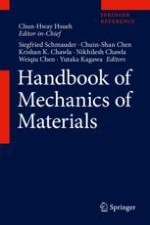2019 | OriginalPaper | Chapter
39. Competing Grain Boundary and Interior Deformation Mechanisms with Varying Sizes
Authors : Wei Zhang, Yanfei Gao, Tai-Gang Nieh
Published in: Handbook of Mechanics of Materials
Publisher: Springer Singapore
Activate our intelligent search to find suitable subject content or patents.
Select sections of text to find matching patents with Artificial Intelligence. powered by
Select sections of text to find additional relevant content using AI-assisted search. powered by
